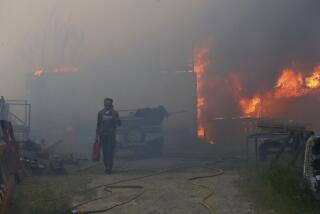Volcanic ash closes European airports
- Share via
Reporting from Los Angeles and London — An immense plume of volcanic ash cast a silent pall over the skies of Northern Europe on Thursday, grounding air traffic across Britain, Scandinavia and elsewhere, halting flights to and from North America, stranding travelers and isolating much of the continent to an extent that was without precedent in recent memory.
2:20 a.m. UPDATE:
According to the Associated Press, aviation authorities say Ireland has lifted restrictions on most of its airspace and reopened airports. The closure of British airspace was scheduled to last until at least 1 a.m. Saturday local time, with perhaps a few exceptions over Northern Ireland and Scotland. —
The culprit: an Icelandic volcano that could continue spewing grit into the atmosphere for months or years to come, experts said, although presumably without a continuing effect on air traffic. However, geologists said it was impossible to predict the behavior of the Eyjafjallajokull volcano, or the prevailing winds.
The material spewed by the volcano consists of fine, sharp-edged particles of rock and glass, most of them ranging in size from about one-twelfth of an inch in diameter down to about 1/25,000th of an inch, and they are capable of circulating in the upper atmosphere for months. If they are inhaled by humans or animals, they can damage air passages. If they are sucked in by a jet engine, they can shut the engine down.
Eurocontrol, Europe’s air traffic control organization, said flights could be disrupted through Saturday. A lack of wind meant the cloud remained dense and was drifting slowly to the east.
Volcanic eruptions “are such a complicated natural phenomenon that almost every one is unique . . . and the amount of ash produced during a given eruption or the length of the eruption is really something that we can’t predict,” said Earth scientist Olivier Bachmann of the University of Washington.
About 4,000 flights were canceled in Europe on Thursday, said Kyla Evans of Eurocontrol. The number could rise to 6,000 on Friday, she said, plus half of all transatlantic flights.
Airports began closing in Britain at 7 a.m. Thursday as the threatening sulfuric cloud began to reach northern Scotland. Among the first to feel the effect directly were residents of the western Norwegian city of Bergen, who began to complain of a strong sulfuric smell about 1 p.m.
“It’s scary that it can spread so far. Just imagine if it had been poisonous,” resident Anne Tomte told the Norwegian newspaper BT.
By late afternoon, all airports in Britain, Ireland, Norway, Sweden and Denmark had been shut down. Finland also closed several of its airports. According to Scandinavian airline SAS, nearly three-quarters of its flights, 635 in all, had been canceled.
Cancellations were also reported in northern Germany, Belgium, the Netherlands, Switzerland and France, where the Charles de Gaulle airport in Paris was shut down. Ripples spread worldwide, as flights to Europe were canceled and flights from Europe failed to arrive. Several flights from the United States were forced to turn back.
It was unclear whether the ash cloud might affect plans for President Obama and other world leaders to attend the funeral Sunday of Polish President Lech Kaczynski, killed Saturday in a plane crash in western Russia.
Flights between Europe and North America represented nearly 15% of all international air travel in 2008, according to the International Air Transport Assn., the trade group that represents most major airlines. Flights in and out of Europe represent nearly 32% of all international flights, according to the IATA.
London-to-New York ranks as the second-busiest international route, carrying nearly 4 million passengers annually, according to the IATA. The Los Angeles-to-London route is the third-busiest across the Atlantic, transporting about 1.5 million passengers per year.
Early Thursday, thousands of people in Europe arrived at airports unaware of the situation.
Hayley Bettany, 25, and her fiance showed up at Britain’s Manchester airport with other members of their wedding party for a flight to the Dominican Republic, where the couple planned to marry on the beach. They found an airport that was clogged with about 45,000 people and 300 grounded aircraft. And they saw their wedding plans go up in smoke.
“We’ve been planning this trip for 16 months. Now a volcano has erupted and spoiled our dream,” Bettany told the Times of London.
At Heathrow airport in London, passengers stared at boards on which every flight was listed as canceled. The airport, one of the world’s busiest, normally handles 1,200 flights and 180,000 passengers a day.
As the day wore on and passengers learned to stay away, airports became uncharacteristically, eerily deserted. Eurostar, the rail service connecting England to the Continent, reported a surge in inquiries and bookings.
Commentators spoke of Britain being brought back to the 19th century, to the days before air travel. Aviation officials said that a complete shutdown of British airspace had not happened in living memory. Even after the Sept. 11, 2001, terrorist attacks, a no-fly zone was imposed only over central London but not the rest of the country.
The closure of British airspace was scheduled to last until at least 1 p.m. Friday.
“However, be aware that the situation cannot be said to be improving with any certainty,” the National Air Traffic Services said late Thursday.
Copenhagen Airport said it would resume flights no earlier than noon Friday. Its closure affected Danes at the highest level: Denmark’s Queen Margrethe II was to mark her 70th birthday Friday with a celebration attended by various crowned heads of Europe, but those guests’ attendance was thrown into doubt.
A Copenhagen Airport spokesman said the airport was handing out blankets and water to stranded passengers.
“I don’t know what’s going to happen. My flight has been canceled, and I don’t have a phone to call the airline with. I think I’ll stay in the airport tonight; I think you can sleep here,” 25-year-old Nick Shown of Maine told the Danish newspaper Politiken.
The disruption came just as airlines were beginning to see international passenger numbers rebound from a steep decline that began in late 2008. The direct economic effect of the disruption was hard to gauge because it was unclear Thursday how many cities would be closed to air traffic and for how long, said Steve Lott, a spokesman for the IATA.
But Lott said the closure of key international hubs, including London and Paris, could also hurt travel and tourism across Europe and in the United States.
“The bottom line is when you start closing or restricting European gateways, it has a ripple effect across the world,” he said.
According to the U.S. Geological Survey, about 100 aircraft have had problems after encountering ash from previous eruptions, but there have been no fatalities.
Times staff writers Ann M. Simmons, Thomas H. Maugh II and Mitchell Landsberg in Los Angeles, Henry Chu in London and special correspondent Helen Hajjaj in Copenhagen contributed to this report.
More to Read
Sign up for Essential California
The most important California stories and recommendations in your inbox every morning.
You may occasionally receive promotional content from the Los Angeles Times.













